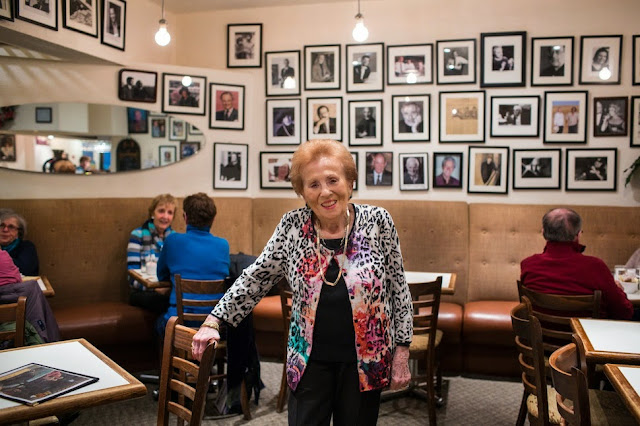Tamarine by Quynh Nhi's Modern South Vietnamese Cuisine
By Bryan Lavery
This sleek and urban-chic downtown hot-spot has a
sophisticated palette and an upscale mix of contemporary Asian-inspired motifs,
art, cuisine and ambiance. Chefs combine the freshest ingredients
with traditional flavours to create a unique menus designed to promote communal
dining.
From a design perspective, the attention to detail is
carried through in many small but striking ways such as the design of the
cutlery and dishes, seasonal exotic floral arrangements and the various choices
of seating arrangements. The mosaic tiles around the bar have a chameleon-like
ability to change into a myriad of palettes, creating a swanky, sexy cocktail
lounge vibe with a colour changing remote control. Lighting can also be
adjusted to set the mood particularly in the far end of the dining room, where
private booth seating provides an intimate and comfortable dining experience.
The cuisine is sophisticated and pushes
culinary boundaries without breaking the tenets of traditional South Vietnamese
cuisine. The flavours are multi-faceted and subtle and the dishes have plenty
of visual appeal. Dishes are designed to be mixed and matched in ways that
balance flavours and fragrance, as well as texture and colour.
The cooking is delicate and refined and combines the
techniques of Chinese cooking with indigenous ingredients, the light accents of
French gentility, and flavours and aromas reminiscent of India.
The signature Crispy Spring Roll at Tamarine is made with
chicken, pork, or a vegetarian version served with fresh mint, lettuce and a
chili-lime fish sauce. The restaurant is also known for its crispy Torpedo
Rolls, made with shrimp and crispy Imperial Rolls with shrimp, pork, wood ear
(a type of fungi) and glass noodles, which are also served with fresh mint,
lettuce and a chili-lime fish sauce. The Vietnamese use fish sauce to enhance
the flavour of their foods, much the same way we use table salt, and it pretty
much goes with everything.
Compared with its cousin, the egg roll, the spring roll is
smaller, with much less filling. (Phan tells me that the “spring roll” is
all about quality, not quantity). However, the terms “spring roll” and “egg
roll,” like “spring roll” and “fresh roll,” are often used somewhat
interchangeably and incorrectly. It can be quite confusing.
Fresh rolls are referred to by several different names,
including “salad roll,” “fresh spring roll,” and “summer roll.” Sometimes the word
“Vietnamese” is added at the beginning of these words; for example, “Vietnamese
roll” or “Vietnamese spring rolls.” It has been my experience that on the North
American west coast, many restaurants refer to fresh rolls as “crystal rolls,”
“soft rolls,” or “salad rolls.” Fresh rolls are easily distinguished from
similar rolls in that they are not fried and that the ingredients used are
different from (deep-fried) Vietnamese egg rolls.
“Spring rolls” take their name from the freshness of the
spring season with all the seasonal ingredients, and frying would, of course
take away that element. At Tamarine, they offer fresh Spring Rolls with a
choice of barbecued chicken or shrimp, vermicelli, crispy pastry heart, fresh
mint, lettuce, and sprouts, all rolled in soft rice paper and served with
peanut sauce.
Tamarine also has its own version of Pad Thai. Although it
is the national dish of Thailand and has been known in various incarnations for
centuries, the dish is thought to have been introduced to Thailand by
Vietnamese traders. Tamarine’s version is a choice of wok-tossed chicken or
beef with rice noodles and bean sprouts, finished with a spicy tamarind sauce
and cilantro lime, and garnished with crushed peanuts.
“Tamarine is a second-generation restaurant. It is our
interpretation of how Vietnamese food has evolved,” says co-owner Long Phan. “Our food
is as symbolic as it is traditional. You can be anywhere in the world and
authentically showcase our heritage with our cuisine.” The cooking remains
delicate and refined and combines the techniques of Chinese cooking with
indigenous ingredients, the light accents of French gentility, and flavours and
aromas reminiscent of both China and India.
Words can describe the atrocities that Vietnamese “boat people”
suffered when they decided to flee their homeland in crudely built boats,
sparking an international humanitarian crisis. When Quynh and Nhi’s father Tan
Pham wanted a better future for his family the authorities caught wind of it
his first attempt to escape the country landed him 20 months of hard labour in
jail. Subsequent attempts yielded him no promises to get him where he wanted to
go. In 1990, he escaped Vietnam literally with the shirt on his back and that
was the price he was willing to pay for a better future for his family. At that
time there was no possible future for his family it was either poverty or
death. The survivors sometimes languished for years in refugee camps. More
fortunate ones were taken in by countries like Canada.
It has been a long journey for the family to get where it is
now but adversity instilled a solid work ethic and team spirit that is evident
in how they operate their restaurants. After making a name for herself at the
Trail’s End Market with her hand-rolled, high quality spring rolls and stir
fry’s, Du Bui (Quynh and Nhi’s mother who has always been in charge of quality)
parlayed her signature spring roll eventually into what her son-in-law, Long
Phan refers to as “the birth of two restaurants.”
Wrapping spring rolls in lettuce leaves and including fresh
herbs in the bundles is a vestige of the original civilizations that existed
before the centuries of Chinese influence in Vietnam, and is practised with
delicacy at both Quynh Nhi and Tamarine.
118 Dundas St, London
www.tamarine.ca.
Tuesday– Saturday 5 pm–9pm
www.tamarine.ca.
Tuesday– Saturday 5 pm–9pm
Friday Lunch 11 am–2:30pm




Comments
Post a Comment